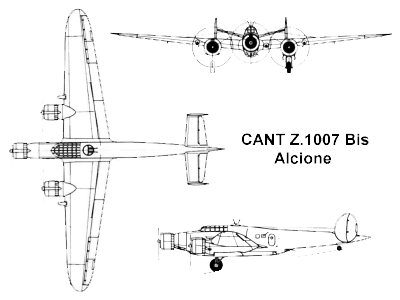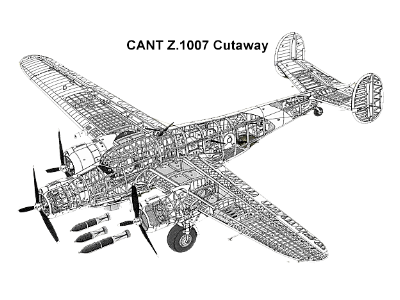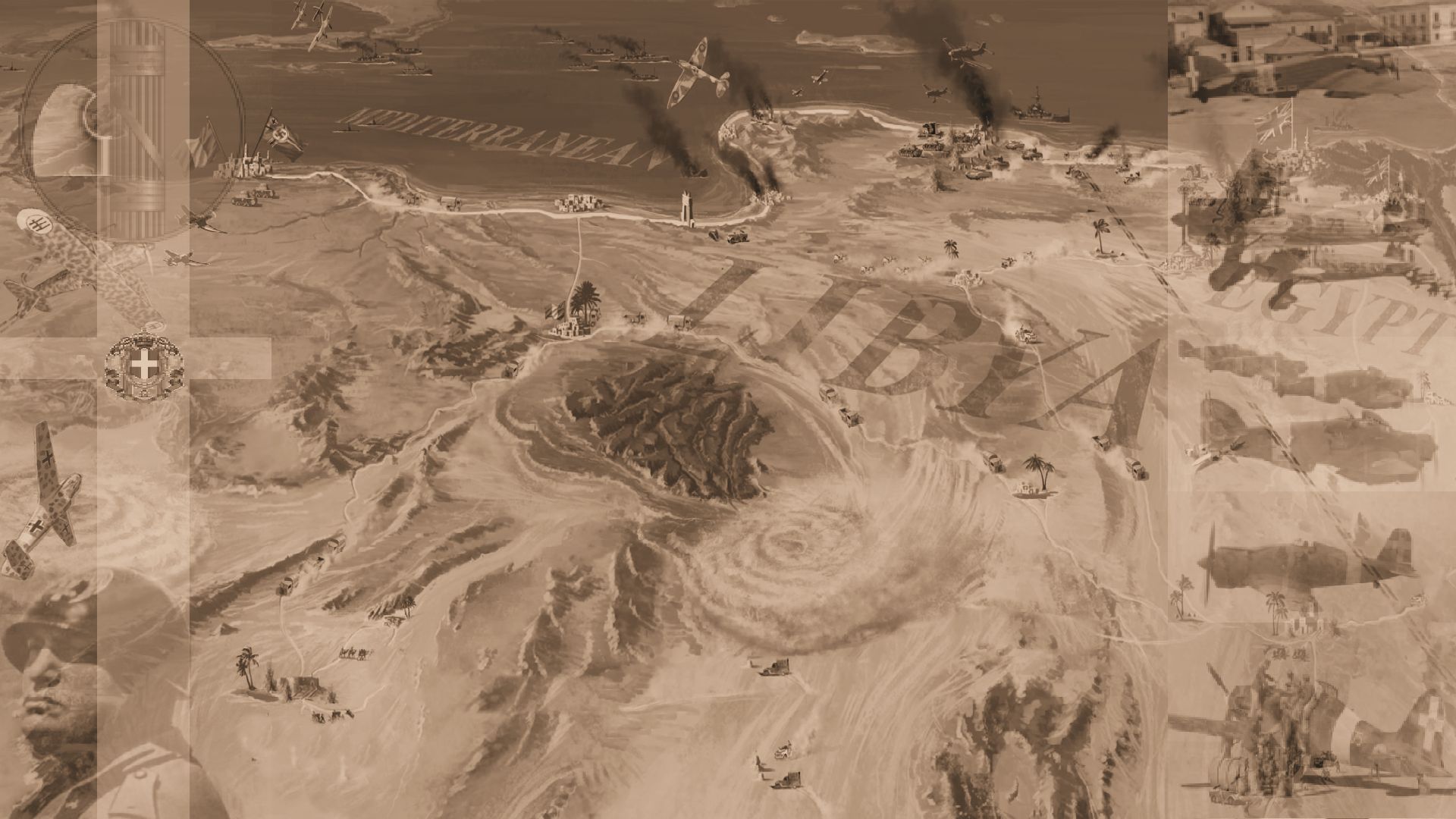 Cant Z.1007 'Alcione' Cant Z.1007 'Alcione'
The CANT Z.1007 'Alcione' (eng:Kingfisher) was a three-engined medium bomber, but designed with a wooden structure. Designed by Filippo Zappata, it had excellent flying characteristics and good stability and was regarded by some as "the best Italian bomber of World War II" although its wooden structure was easily damaged by the climate such as North Africa and Russia. Along with the Savoia-Marchetti S.M.79, the CANT Z.1007 'Alcione' series of bombers served as the backbone of the Regia Aeronautica's conventional and torpedo strike forces in World War II.
Development
The Cant Z.1007 was developed from the CANT Z.506 seaplane, an aircraft that had established many world records in the late 1930s. It was a land-based version and incorporated many improvements, especially on the powerplant. It was designed as a mid-winged monoplane with a retractable tailwheel undercarriage, had a crew of five, consisting of two pilots, a flight engineer, a radio operator and a bombardier/navigator. It could carry 800 kg (1,760 lb) of bombs, and was fitted with a defensive armament of a 12.7 mm (.5 in) Breda-SAFAT machine gun in an open dorsal position and a 7.7 mm machine gun in a ventral tunnel. After much experimentation with the prototype, the production aircraft were fitted with annular radiators so their profile was similar to radial engines that would be fitted to the improved later versions. The first prototype flew in March 1937, proving superior to the Z.1011, with its handling and manoeuvrability being praised. Its performance, however, was lower than predicted, and Zappata therefore started a major redesign of the Z.1007, production of the initial version being limited to the existing orders placed before the prototype flew. Delivery of production Asso powered Z.1007s started in February 1939, with production ending in October that year. Zappata had, meanwhile, continued the development of a considerably changed version, the Z.1007bis, to resolve the problems with the original aircraft. While the new version was of similar layout, it was a new design. Three Piaggio P.XI RC.40 radial engines replaced the less powerful and unreliable liquid cooled engines of the original version. The bis was longer with wings of greater span and area, while the aircraft was considerably heavier, weighing 580 kg (1,280 lb) more unladen, with a maximum takeoff weight 888 kg (1,960 lb) greater, while it carried heavier offensive and defensive armament. The Z.1007 also suffered longitudinal stability problems that were partly rectified later by the adoption of a twin tail arrangement and poor engine reliability because of a weak power-to-weight ratio due to low powered engines. Back to Top
Into service
The first Asso-powered Z.1007s were used to equip the 50° Gruppo of the 16° Stormo (i.e. the 50° Gruppo of the 16° Stormo) from May 1939. The Asso powered bombers were not considered suitable for operational use, however, owing to the unreliability of their engines and high maintenance requirements, while their defensive armament was considered inadequate so they were therefore used as trainers. When Italy entered the war on 10 June 1940 the Regia Aeronautica had 87 CANT Z.1007 and Z.1007bis bombers in commission, of which 38 were serviceable. Regia Aeronautica had two Stormi equipped with the "Alcione". One was the 16°, with 31 aircraft, equipped with the Isotta Fraschini engine and so declared 'non bellici' (not suitable for war). The 47° Stormo had just received four CANT bis. The Z.1007 participated in the bombing campaign over Malta and in the campaigns in North Africa and on the Eastern Front.
Although fast, these bombers were vulnerable when hit and prone to catch fire. The 47° Stormo was equipped with some of the first production aircraft at Ghedi. Only four were in service at 10 June 1940. The Z.1007 saw action during the later stages of the Battle of Britain from November 1940 to January 1941. The Regia Aereonautica sent six Z.1007Bis of the 172a Squadriglia to Belgium in the strategic reconnaissance role for the Corpo Aereo Italiano. They were used in force only once, on 11 November 1940, when five were used as a decoy (without bombs or guns) to draw RAF fighters away from the main Italian attack on a convoy and the port facilities around Harwich by 10 Fiat BR 20 bombers which ended in failure. Cant Z.1007 Asso replaced SM.81s in 16° Stormo, 47° Stormo had Z.1007Bis but operational readiness was only reached in August, when around 30 machines were sent to Sicily to attack Malta. Stormi 16°, 12°, 35°, and 47° operated over Greece with some losses. 175a Squadriglia da ricognizione (reconnaissance squadron), and later 176a, were used in Africa. 35° Stormo was sent to Africa in the bombing role. The first large-scale use of the Z.1007 took place during the Italian invasion of Greece started at the end of October 1940. Later as the battle of Malta raged, Italian and German efforts to stop the British Operation Pedestal convoy to re-supply Malta in August 1942, a few Z.1007 Alciones of 51° Gruppo Autonomo based in Alghero, Sardinia, flew reconnaissance missions on the convoy between bombing and raids. Only on 14 August, at the end of that 'Mid-August Battle', three Z.1007bis bombed the convoy from high altitude. The only considerable success of the Z.1007 was when the British destroyer HMS Juno was sunk by an explosion caused by a Z.1007 bombing in 1941. Back to Top
Final battles
Z.1007s were used mainly as night bombers and reconnaissance, they were also used for long range reconnaissance, with excellent results. Some, at least 20, were equipped with an auxiliary tank that gave 1,000 km (620 mi) extra endurance. Some were adapted for flare drops when day missions were too dangerous. One modification for photo missions had six robot machines in a ventral gondola plus another in the fuselage. The long range and the ceiling helped these aircraft to obtain good results until the Spitfires appeared on the Mediterranean theatre. They were also the first victims of P-40 'Tomahawks' over Alexandria. In June 1943, the Z.1007s at Perugia, originally equipped with 30 machines, dropped to 19 with 13 serviceable in September. At the Armistice there were approximately 72 machines in service, with 40 of them sent to southern Italy which were used as fast transports. The worst day for Z.1007s was 14 May 1944, when 88° Gruppo sent 12 Z.1007s carrying supplies to Tito's forces in Yugoslavia. Five were shot down and two damaged by German fighters, 26 Italian aviators were killed. From that day on, it was employed only at night for military purposes. Some thirty-five CANT Z.1007ters were produced; production of the CANT Z.107bis and Z.1007ter (Piaggio P.XIX engines) amounted to 526. Back to Top
|
 Cant Z.1007 3 View
Cant Z.1007 3 View
 Cant Z.1007 Cutaway
Cant Z.1007 Cutaway
|
Specifications(Z.1007bis):-
Country of Origin: Italy
Crew: 5 (pilot, co-pilot, flight engineer/gunner, radio operator, bombardier)
Length: 18.35 m (60 ft 2.5 in)
Wingspan: 24.80 m (81 ft 4.5 in)
Height: 5.22 m (17 ft 1.5 in)
Empty weight: 9,396 kg (20,715 lb)
Loaded weight: 13,621 kg (30,029 lb)
Powerplant: 3 × Piaggio P.XI RC.40 radial engines, 745 kW (1,000 hp) each
Performance
Maximum speed: 458 km/h (245 kn, 285 mph)
Range: 1,795 km (969 nmi, 1,115 mi)
Service ceiling: 7,500 m (25,000 ft)
Armament
Guns:2 × 12.7 mm (0.5 in) Isotta-Fraschini Scotti or Breda-SAFAT machine guns
2 × 7.7 mm (0.303 in) Breda-SAFAT machine guns
Bombs: 1,200 kg (2,645 lb) of bombs internally. 1,000 kg (2,200 lb) externally on underwing hardpoints
or a combined load of 2,200 kg (4,900 lb) of bombs internally and on external hardpoints
or 2 × 450 mm (17.7 in) 800 kg (1,800 lb), torpedoes
SM.79 Sparviero Poster from MilMerchant at Redbubble

Check out MilMerchant at CafePress
Back to Top
|
|


